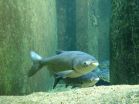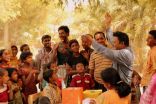Model offers more ease, precision for managing invasive Asian carp
2015-04-16
(Press-News.org) The likelihood of Asian carp eggs being kept in suspension and hatching in the St. Joseph River in Michigan has been further evaluated using a model that examines a range of multiple flow and water temperature scenarios. Results illustrate the highest percentage of Asian carp eggs at risk of hatching occurs when the streamflow is low and when the water temperature is high. This new study by the University of Illinois and the U.S. Geological Survey (USGS) is published in the Journal of Great Lakes Research.
"In this study, the Fluvial Egg Drift Simulator (FluEgg) model allowed us to examine the complex dependencies between flow, temperature, and egg development," said USGS hydrologist Ryan Jackson. "This information provides resource managers with a range of conditions under which the St. Joseph River is vulnerable to Asian carp reproduction."
The FluEgg model was used to evaluate egg movement and the likelihood of successful Asian carp reproduction under different streamflow and temperature conditions representative of historical spawning seasons in the St. Joseph River, a tributary to Lake Michigan. Results show that eggs develop faster at warmer water temperatures, therefore requiring less time to drift in the river until hatching. Low streamflows can also be conducive to reproduction when the streamflow is just fast enough to keep most of the eggs in suspension while allowing for the greatest amount of drift time before reaching the lake, thus increasing the likelihood of hatching.
The FluEgg model, developed by University of Illinois researchers in collaboration with the USGS, was first introduced in 2013. The latest version of the model is available online and includes a user-friendly interface and improved predictions of egg transport in rivers.
Invasive Asian carp consume plankton from the base of the food web and reproduce prolifically which could pose substantial environmental risks and economic impacts to the Great Lakes if they become established.
"This work focuses on the early life stages of Asian carp," said USGS research fish biologist Duane Chapman. "Targeting early life stages can include disrupting spawning activities or egg development in rivers where Asian carp spawn."
Several factors affect the viability of the eggs. The temperature of the water affects how long the eggs need to hatch, and the velocity of the river affects the movement of the eggs and whether the eggs remain in suspension or sink to the bottom. Eggs that settle on the riverbed will likely die, and eggs that are transported down the river and into a lake may not have enough time to develop to the hatching stage before settling to the lakebed.
The reproduction assessment of Asian carp eggs in the St. Joseph River demonstrated the complexity of the problem where the length of the river, velocity and water temperatures cannot be assessed individually. Rather, a holistic analysis is required, where egg development, water-quality characteristics and the hydrodynamics of the river are interconnected and analyzed together.
"Successful reproduction requires a fine balance between the rate of egg development and the variable flow conditions present in a river required to maintain the eggs in suspension," said Tatiana Garcia, USGS research hydrologist and lead author of the paper.
INFORMATION:
The paper, "Application of the FluEgg model to predict transport of Asian carp eggs in the St. Joseph River (Great Lakes tributary)" by Tatiana Garcia, Elizabeth A. Murphy, Patrick R. Jackson, and Marcelo H. Garcia, is available online.
[Attachments] See images for this press release:


ELSE PRESS RELEASES FROM THIS DATE:
2015-04-16
Biological diversity brings beauty and variety to our lives and to the world around us. It also could be the key to keeping ecosystems strong, according to a new University of Minnesota study published April 17 in the journal Science.
The study, led by Yann Hautier a Marie Curie Fellow associated with the College of Biological Sciences at the University of Minnesota and with the University of Oxford, U.K., looked at 28 years' worth of data on plant growth, number of species, ecosystem stability and exposure to changes in nitrogen, carbon dioxide, fire, grazing and water ...
2015-04-16
Through a combination of data analysis and numerical modeling work, researchers have found a record of the ancient Moon-forming giant impact observable in stony meteorites. Their work will appear in the April 2015 issue of the Journal Science. The work was done by NASA Solar System Exploration Research Virtual Institute (SSERVI) researchers led by Principal Investigator Bill Bottke of the Institute for the Science of Exploration Targets (ISET) team at the Southwest Research Institute and included Tim Swindle, director of the University of Arizona's Lunar and Planetary Laboratory.
The ...
2015-04-16
A skin cell responsible for scarring, and a molecule that inhibits the cell's activity, have been identified by researchers at the Stanford University School of Medicine.
The molecule slowed wound healing in mice but alleviated scarring, the researchers said.
The researchers also found that the cell may play a role in the growth of melanoma and in skin damage caused by radiation. A drug that acts in the same way as the inhibitory molecule is already approved for use in humans as a treatment for type-2 diabetes, so it could potentially move quickly into clinical trials ...
2015-04-16
For more than 250 million years, four-limbed land animals known as tetrapods have repeatedly conquered the Earth's oceans. These creatures--such as plesiosaurs, penguins and sea turtles--descended from separate groups of terrestrial vertebrates that convergently evolved to thrive in aquatic environments.
In a new scientific review, a team of Smithsonian scientists synthesized decades of scientific discoveries to illuminate the common and unique patterns driving the extraordinary transitions that whales, dolphins, seals and other species underwent as they moved from land ...
2015-04-16
Supermassive black holes, often with masses billions of times that of the Sun, are located at the heart of almost all galaxies in the Universe. These black holes can accrete huge amounts of matter in the form of a surrounding disc. While most of this matter is fed into the black hole, some can escape moments before capture and be flung out into space at close to the speed of light as part of a jet of plasma. How this happens is not well understood, although it is thought that strong magnetic fields, acting very close to the event horizon, play a crucial part in this process, ...
2015-04-16
A global study on canine rabies, published today (16 April 2015), has found that 160 people die every single day from the disease. The report is the first study to consider the impact in terms of deaths and the economic costs of rabies across all countries. Even though the disease is preventable, the study says that around 59,000 people die every year of rabies transmitted by dogs.
The multi-author study, by the Global Alliance for Rabies Control's Partners for Rabies Prevention Group, also shows that annual economic losses because of the disease are around 8.6 billion ...
2015-04-16
Scientists have discovered a protein that plays a central role in promoting immunity to viruses and cancer, opening the door to new therapies.
Experiments in mice and human cells have shown that the protein promotes the proliferation of cytotoxic T cells, which kill cancer cells and cells infected with viruses. The discovery was unexpected because the new protein had no known function and doesn't resemble any other protein.
Researchers from Imperial College London who led the study are now developing a gene therapy designed to boost the infection-fighting cells, and ...
2015-04-16
A major astrophysical mystery has centred on how massive, quiescent elliptical galaxies, common in the modern Universe, quenched their once furious rates of star formation. Such colossal galaxies, often also called spheroids because of their shape, typically pack in stars ten times as densely in the central regions as in our home galaxy, the Milky Way, and have about ten times its mass.
Astronomers refer to these big galaxies as red and dead as they exhibit an ample abundance of ancient red stars, but lack young blue stars and show no evidence of new star formation. The ...
2015-04-16
San Antonio -- April 16, 2015 -- A NASA-funded research team led by Dr. Bill Bottke of Southwest Research Institute (SwRI) independently estimated the Moon's age as slightly less than 4.5 billion years by analyzing impact-heated shock signatures found in stony meteorites originating from the Main Asteroid Belt. Their work will appear in the April 2015 issue of the journal Science.
"This research is helping to refine our time scales for 'what happened when' on other worlds in the solar system," said Bottke, of the Institute for the Science of Exploration Targets (ISET). ...
2015-04-16
April 16, 2015, NEW HAVEN, CT - With poor sanitation estimated to cause 280,000 deaths per year worldwide, improving sanitation is a key policy goal in many developing countries. Yet governments and major development institutions disagree over how to address the problem. A new study released in Science today found that in Bangladesh, a community-motivation model that has been used in over 60 countries to increase use of hygienic latrines had no effect, yet latrine coverage expands substantially when that model is combined with subsidies for hygienic latrines targeted to ...
LAST 30 PRESS RELEASES:
[Press-News.org] Model offers more ease, precision for managing invasive Asian carp






